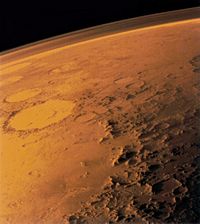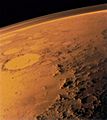Atmosphere of Mars facts for kids
The atmosphere of Mars is the layer of gases surrounding Mars. It is mainly made up of carbon dioxide. The average atmospheric pressure of the Martian surface (6.0 mbar) is much lower than that of the Earth (1,013 mbar). The pressure is well below the Armstrong limit, meaning that water boils at the normal temperature of the human body: 98.6 °F (36.6 °C).
The Martian atmosphere contains 96% carbon dioxide, 1.9% argon, 1.9% nitrogen, and traces of oxygen, carbon monoxide, water and methane, and so on. Ever since the discovery of methane in 2003, scientists say that this might indicate life. It has also been suggested that is may be caused by geochemical processes, volcanic or hydrothermal activity.
The atmosphere of Mars is quite dusty, giving the Martian sky a light brown or orange-red color when seen from the surface. Data from NASA pointed out that the dust particles are 1.5 micrometres diameter. Planet-encircling dust storms (global dust storms) occur on average every 5.5 Earth years (every 3 Martian years) on Mars and can threaten the operation of Mars rovers. However, the mechanism responsible for the development of large dust storms is still not well understood. It has been suggested to be loosely related to gravitational influence of both moons, somewhat similar to the creation of tides on Earth.
On 18 March 2015, NASA found an aurora that is not fully understood and an unexplained dust cloud in the atmosphere of Mars.
Liquid water on Mars was once commonplace, which means the atmosphere was thicker. Many studies have found that the atmosphere of Mars has been weakened over time due to solar winds. On Earth, the magnetic field protects us from most of the wind. Mars used to have a magnetic field, but cooling of the core has resulted in the magnetic field being lost.
The atmosphere of Mars is colder than Earth's. Owing to the larger distance from the Sun, Mars receives less solar energy and has a lower effective temperature, which is about 210 K (−63 °C; −82 °F). The average surface emission temperature of Mars is just 215 K (−58 °C; −73 °F), which is comparable to inland Antarctica. Although Mars' atmosphere consists primarily of carbon dioxide, the greenhouse effect in the Martian atmosphere is much weaker than Earth's: 5 °C (9.0 °F) on Mars, versus 33 °C (59 °F) on Earth. This is because the total atmosphere is so thin that the partial pressure of carbon dioxide is very weak, leading to less warming. The temperature can range from −75 °C (−103 °F) to near 0 °C (32 °F) near the surface in some regions. The temperature of the upper part of the Martian atmosphere is also significantly lower than Earth's because of the absence of stratospheric ozone and the radiative cooling effect of carbon dioxide at higher altitudes.
Potential for use by humans
The atmosphere of Mars is a resource of known composition available at any landing site on Mars. It has been proposed that human exploration of Mars could use carbon dioxide (CO2) from the Martian atmosphere to make methane (CH4) and use it as rocket fuel for the return mission.
In 2021, however, the NASA rover Perseverance was able to make oxygen on Mars. The process is complex and takes a lot of time to produce a small amount of oxygen.
Images for kids
-
Argon isotope ratios are a signature of atmospheric loss on Mars.
-
Dust devil on Mars - viewed by the Curiosity rover - (August 9, 2020)
-
Mars Pathfinder – Martian sky with water ice clouds.
See also
 In Spanish: Atmósfera de Marte para niños
In Spanish: Atmósfera de Marte para niños



















